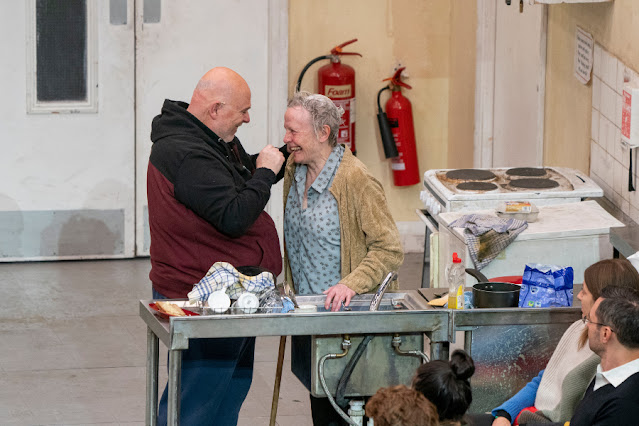A heart-breakingly realistic play about the inhabitants of a temporary housing facility that celebrates love and humanity.
For LOVE, first staged at the Royal National Theater in 2016, the vast space of the Park Avenue Armory's drill hall is “shrunk” to the size of a cramped communal space in a temporary housing facility. Some audience members are seated on bleachers on either side of the set, or on plastic chairs that share the floor with the inhabitants of this gloomy establishment. Harsh fluorescent lights stretch overhead above, illuminating both the stage and the auditorium as if to say that we all walk under the same sky.
This blurring of theatre and reality is at the heart of Alexander Zeldin’s play, which originated from interviewing, and even improvising scenes with, people who lived in various emergency housing facilities in the UK. The realistic set and costume design by Natasha Jenkins is appropriately dull and depressing, with grimy pale yellow walls, cast-off clothes presumably procured from thrift shops and aid agencies, and multiple numbered doors, each containing a family, a love story, and a silent cry for help.
How is one supposed to live and care for children or an aging parent in the conditions of severely limited privacy, while fighting the many-headed hydra of bureaucracy? In a string of devastatingly mundane scenes, we witness how Dean (Alex Austin) tries his best to maintain healthy routines for his two kids, the relentlessly optimistic Paige (Amelia Finnegan, alternating with Grace Willoughby) and the surly Jason (Oliver Finnegan). Dean's pregnant partner Emma (Janet Etuk), desperate to get out of housing limbo before her baby is born, struggles to find the time and energy for her training in massage therapy.
While initially confident they won't be here long, Dean and Emma are shocked to learn that Colin (Nick Holder) has been stuck in the shelter for a year now, where he does his best to care for his aging mother Barbara (Amelda Brown). Meanwhile, Sudanese immigrant Tharwa (Hind Swareldahab) and Syrian refugee Adnan (Naby Dakhli) mostly stick to their rooms, only becoming animated when talking to each other in their shared language.
LOVE explores daily life in a place that is never fully private or public, revealing how even something as small as a misplaced mug can ratchet up the tension between both family members and strangers. But Zeldin's play also reveals so much kindness and, yes, love. One can tell that love was a driving force of this project. For all of the stress these characters must deal with, love is spoken often, sometimes casually, yet always sincerely. Love is also transmitted through gestures of care, like Colin's playful washing of his mother’s hair in the kitchen sink.
LOVE is filled with realistic moments that may indeed feel familiar, regardless of circumstance. Scenes of food—preparing it, serving it, eating it—are done in real time, making them feel closer to the skin. When was the last time you saw an actor eat an entire meal, and not just take a symbolic bite? Yet the emotional heft of such scenes can shift quickly. Once left alone with a melancholy Colin, as he chews on a drab bread and butter sandwich, we feel the dread of an entire year living in this facility, having these same boring meals while staring at the same dirty wall with the same print of Vettriano's The Singing Butler.
Of course, most hated of all is the shared bathroom, around which such communal life must revolve. People impatiently wait for each other to leave, sneaking sheepishly in and out, clutching their thin rolls of toilet paper. Love opens with such bathroom-related stress; likewise, its climax is centered around it. But hardly anything gets resolved. Christmas is nearing, and we want to believe that everything will be OK.
As we step outside the theatre, we of course face the reality that inspired LOVE: homeless people curled up in the niches of buildings and on the subway. A note in the program addresses this, arguing that LOVE "challenges audiences to not look away, but to confront the reality of homelessness, dispelling stereotypes and stigma." Yet it is admittedly deeply uncomfortable to go from admiring the aestheticization of staged misfortune to feeling paralyzed when walking past real people experiencing even worse circumstances. Or perhaps this is exactly the point.
(LOVE plays at Park Avenue Armory, 643 Park Avenue, through March 25, 2023. The running time is 90 minutes with no intermission. Performances are Mondays through Thursdays at 7:30, Fridays at 8, and Saturdays at 2 and 8. Tickets are $54 - $154 and are available at armoryonpark.org or by calling (212) 933-5812.)
LOVE is written and directed by Alexander Zeldin. Set and Costume Design by Natasha Jenkins. Lighting Design by Marc Williams. Sound Design by Josh Anio Grigg. Movement by Marcin Rudy. Fight Director is Kev McCurdy. Associate Director is Elin Schofield. Company Stage Manage is Alison Rankin. Deputy Stage Manager is Charlotte Verriez. Assistant Stage Manager is Tash Savidge.
The cast is Alex Austin, Amelda Brown, Naby Dakhli, Janet Etuk, Amelia Finnegan, Oliver Finnegan, Nick Holder, Hind Swareldahab, and Grace Willoughby.
(this review was published on theasy.com)






